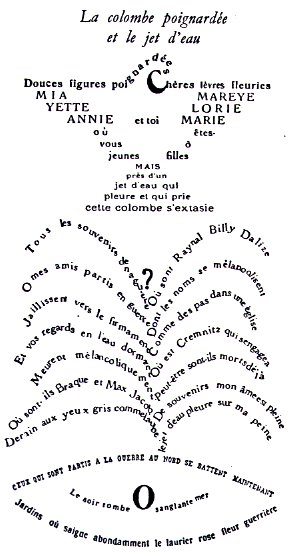English translation of the dove stabbed and the fountain :
Gentle faces stabbed dear flowered lips
Mia, Mareye,
Yette, Lorie,
Annie and you Marie
Where are you O young girls?
But near a fountain
that cries and that prays
This dove is in ecstasy
All the memories of longing
of my friends gone to war
Spurt to the firmament
And your look in water which sleeps
Melancholy die
Where are Braque and Max Jacob
Derain with eyes grey as dawn
Where are, Raynal, Billy, Dalize
Their names are spleen
Like steps in a Church
Where is Cremnitz who engaged
Maybe they are already dead
my soul is full of memories
Fountain cries on my grief
Those who left for the war
In the North are fighting now
Night falls O! Blood-dreched sea
Gardens where bled in abandon
the laurel rose flower of war

Mia, Mareye,
Yette, Lorie,
Annie and you Marie
Where are you O young girls?
But near a fountain
that cries and that prays
This dove is in ecstasy
All the memories of longing
of my friends gone to war
Spurt to the firmament
And your look in water which sleeps
Melancholy die
Where are Braque and Max Jacob
Derain with eyes grey as dawn
Where are, Raynal, Billy, Dalize
Their names are spleen
Like steps in a Church
Where is Cremnitz who engaged
Maybe they are already dead
my soul is full of memories
Fountain cries on my grief
Those who left for the war
In the North are fighting now
Night falls O! Blood-dreched sea
Gardens where bled in abandon
the laurel rose flower of war

Apollinaire publishes his first “lyrics ideogram” in July 1914 in the journal named “les soirées de Paris”, which he later gave the name of Calligrammes. Apollinaire, who was a famous art critic since 1905, would rivaled with painters thanks to his collection. Indeed in the beginning of the twentieth century writers and painters were bind up by the surrealism. Thus they knew and they impacted each other. War interrupted this intellectual group.
A calligram is a poem in which words are set in order to form a drawing with regard to the meaning of the poem but sometimes the drawing can create a paradox between it and the poem. Apollinaire creates the word calligram. It’s a combination of “calligraphy” and “ideogram”. He uses the word for the first time in his collection calligrammes. The word “calligram” mean etymologically “beautiful” from Greek Kali and “sign of scripture” of gramma. For Apollinaire it was a way to “write with beauty”.
What vision of the war emerges from calligram? Why this poem is engaged against the war?
We note two parts in this poem. From the top, the first drawing is a dove “dove stabbed” and the second represent a fountain “the fountain”. So the drawing and the text are a common sense. In his famous rhyme “oh god, what a lovely war” Apollinaire would say that there is compensation in war, moment of true happiness on the firing line. Thus is undeniable, Apollinaire loved the war but also loathed it: “if you could see this country, these holes to men, everywhere, everywhere! We are disgusted by it, hoses, shell holes, the fragments of missiles and graveyards” Apollinaire. We note these inconstancies in the calligram. The last rhyme opposes life “ gardens “, “laurel”, “flowers” to the death “warlike”, “bloody”, “bleeds”. The garden associate to the blood can reminds the Garden of Gethsemane where the Christ was arrested before be crucify. Thus that translates the grief and the suffering of the poet but the association of pink laurel which symbolize the frivolous love to the war “war flower” can reveal likewise that Apollinaire love the war. In the same vein, the drawing of a fountain suggests at the same time a vertical movement “spurt to the firmament” but too a fall “night falls”.
We can increase the semantic field of melancholy throughout the poem “keepsake”, “melancholically”. It’s a major theme of elegiac poetry. Alike the theme of lost love “Mia, Mareye, Yette, Lorie Annie and you Marie » these names begin all by capitals letters. So they are important for Apollinaire. Indeed Apollinaire was madly in love with Annie Playden who was the English governess of Apollinaire’s children. She refused all advances of Apollinaire. In 1902 Apollinaire returned in France and Annis went to United States. Apollinaire wrote several poems to Annie Playden for example: Annie et la chanson du mal aimé. Marie Laurencin has also marked life and a lot of poems of Apollinaire. The poem is elegiac too because Apollinaire uses the anaphora of “where”, he asks him “where are his friends because “Braque and Max Jacob”,”Raynal, Billy, Dalize” also rubbed shoulders with Apollinaire. Braque and Derain were painter, designer and engraver between 1909 and 1911. Max Jacob was a French poetry. He writes Cornet à dés in 1917. Raynal, Billy and Dalize were friends of Apollinaire together they created before the war the journal Les soirées de Paris. War is synonymous with loss for Apollinaire who is homesick.
Rhymes “but near a fountain that cries and that prays” and “fountain which cries on my grief” can be read into a personification, fountain represents Apollinaire who is crying and the drawing of the fountain is an eye and the water shoot symbolize tears. War is therefore synonymous with sadness for Apollinaire but we can moderate this because when the author uses the semantic field of religion “church”, “prays”. Apollinaire still hopeful, he uses the adverb “maybe” which translates assumptions. Apollinaire doesn’t want conceive his friends dead.
The calligram emits a negative image of the war: it’s synonymous with loss and grief. But we can wonder if Apollinaire sees in war a kind of hope, future.
Back to the french version : http://tpe-poetes-engages.wifeo.com/la-colombe-poignardee-calligrammes-apollinaire.php
